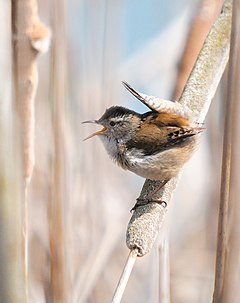Troglodytidae
| Wren | |
|---|---|
 |
|
| Marsh wren (Cistothorus palustris) | |
| Scientific classification | |
| Kingdom: | Animalia |
| Phylum: | Chordata |
| Class: | Aves |
| Order: | Passeriformes |
| Suborder: | Passeri |
| Superfamily: | Certhioidea |
| Family: |
Troglodytidae Swainson, 1832 |
The wrens are mostly small, brownish passerine birds in the mainly New World family Troglodytidae. About 80 species of true wrens in roughly 20 genera are described. Only the Eurasian wren occurs in the Old World, where in Anglophone regions, it is commonly known simply as the "wren", as it is the originator of the name. The name wren has been applied to other, unrelated birds, particularly the New Zealand wrens (Acanthisittidae) and the Australian wrens (Maluridae).
Most wrens are small and rather inconspicuous, except for their loud and often complex songs. Notable exceptions are the relatively large members of the genus Campylorhynchus, which can be quite bold in their behavior. Wrens have short wings that are barred in most species, and they often hold their tails upright. As far as known, wrens are primarily insectivorous, eating insects, spiders, and other small arthropods, but many species also eat vegetable matter and some take small frogs and lizards.
The English name "wren" derives from Middle English wrenne, Old English wrænna, attested (as werna) very early, in an eighth-century gloss. It is cognate to Old High German wrendo, wrendilo, and Icelandic rindill (the latter two including an additional diminutive -ilan suffix). The Icelandic name is attested in Old Icelandic (Eddaic) rindilþvari. This points to a Common Germanic name *wrandjan-, but the further etymology of the name is unknown.
The wren is also known as kuningilin "kinglet" in Old High German, a name associated with the fable of the election of the "king of birds". The bird that could fly to the highest altitude would be made king. The eagle outflew all other birds, but he was beaten by a small bird that had hidden in his plumage. This fable is already known to Aristotle (Historia Animalium 9.11) and Pliny (Naturalis Historia 10.74), and was taken up by medieval authors such as Johann Geiler von Kaisersberg, but it concerns Regulus, and is apparently motivated by the yellow "crown" sported by these birds (a point noted already by Ludwig Uhland). In modern German, the name is Zaunkönig, king of the fence (or hedge). In Dutch, the name is winterkoninkje (little winter king).
...
Wikipedia
